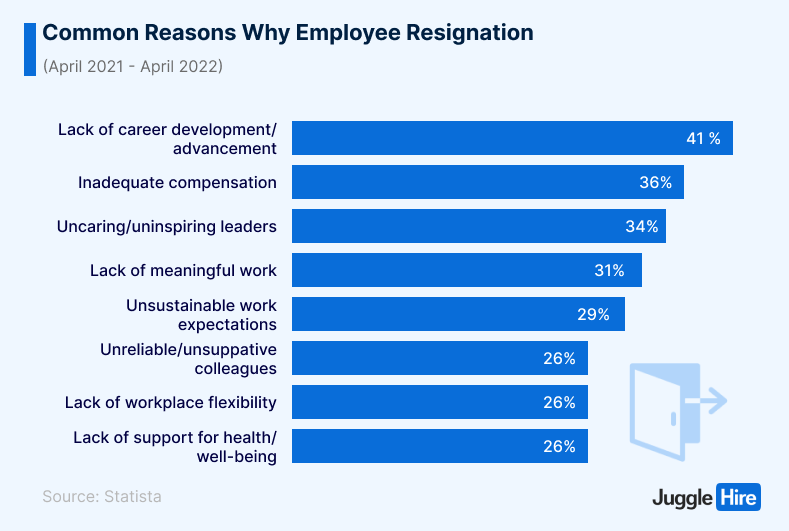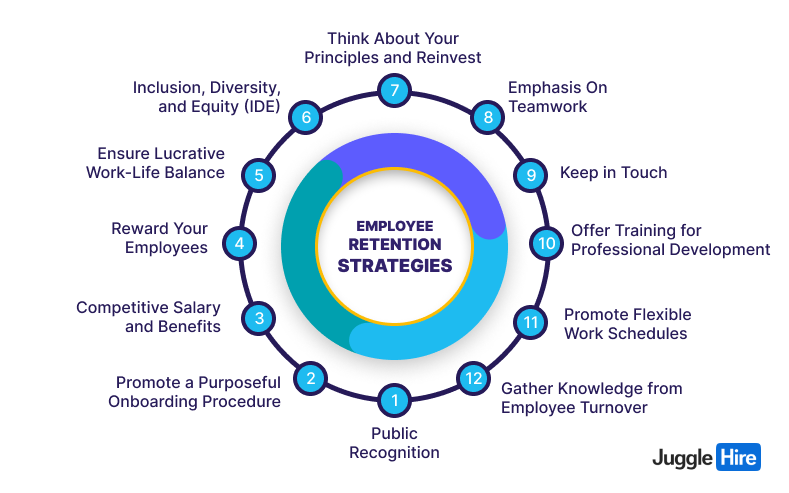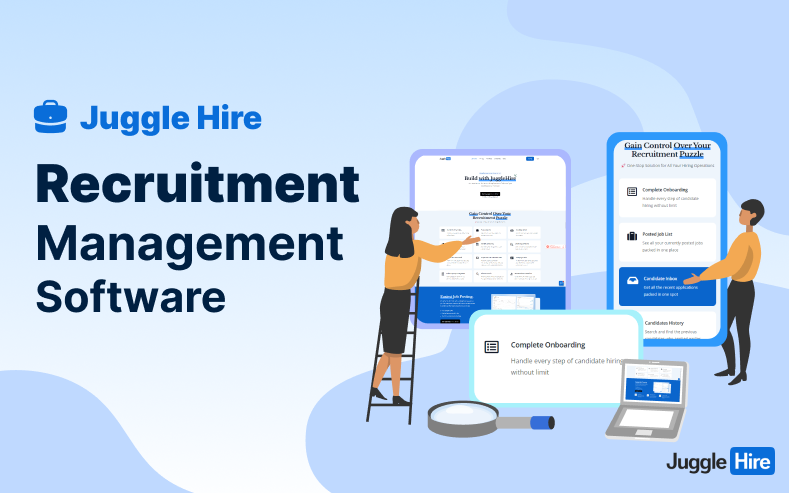12 Employee Retention Strategies for Small Businesses

Nowadays, small businesses face a constant challenge- retaining their valuable employees. Employee retention strategies are crucial for ensuring the stability and growth of small businesses.
However, labor shortages are impacting businesses across various industries. Therefore, retaining skilled employees has become increasingly difficult.
Over half of small businesses are currently grappling with labor shortages, with significant implications for their operations
Bank of America
In this context, implementing effective employee retention strategies becomes imperative for small businesses to thrive amidst competition and uncertainty.
If you’re wondering how to plan for employee retention strategies, you are in the right place. Today, we are going to show you 12 employee retention strategies for small businesses. So, let’s get started!
What is Employee Retention?
Employee retention is all about keeping your employees happy and motivated so they stick around. It’s like the opposite of turnover, which is when people leave your company.
So, if you want to measure it, you look at how many folks are still with you compared to those who’ve left over a certain time. High turnover is a sign that something’s not right. So, it’s important to work on keeping people on board.
When employees feel valued and fulfilled, they’re more likely to stick around for the long haul. Basically, it is about making your workplace a great environment where people want to stay. That means –
- Creating a positive culture
- Making sure everyone feels appreciated
- Offering competitive pay and benefits
- Supporting a healthy work-life balance
Why Employee Retention is Important for Small Businesses

Employee retention is crucial for small businesses for several reasons. First, it helps you avoid the headaches and costs of constantly finding and training new employees. When people stick around, you save money and time on onboarding and training replacements.
Plus, replacing employees can be pricey—sometimes up to half or even twice their annual salary!
Keeping your team intact also boosts productivity. New hires often take time to get up to speed, so having a stable team means you can maintain output without any slowdowns. It also keeps morale high and prevents burnout since your existing team won’t feel overburdened by constantly covering for vacancies.
Consistency is key for customer experience too. With a steady team, you ensure that customers receive the same level of service every time they interact with your business. And let’s not forget about company culture — when people stay, they build relationships and a sense of camaraderie, making the workplace more enjoyable for everyone.
Ultimately, higher retention rates lead to better profitability. You save on hiring expenses, maintain productivity, and keep customers happy, all of which contribute to a healthier bottom line. So, for small businesses, investing in employee retention isn’t just a good idea — it’s essential for long-term success.
You Might be Interested In –
Killer Tips to Hire the Right Candidate in a Cutthroat Job Market
Effects of Employee Turnover on Small Businesses
- Financial burden: According to the Center for American Progress, turnover costs can range from 16% to 213% of the lost employee’s salary, impacting the bottom line.
- Disrupted workflow: Unfinished tasks left by departing employees can strain remaining team members and lead to decreased productivity.
- Decreased revenue: Productivity losses and workflow disruptions can result in revenue suffrage for the business.
- Decline in team morale: Extra workload and uncertainty about the future can lead to burnout and morale issues among remaining employees.
- Impact on clients/customers: Direct contact with clients may be lost, leading to confusion and dissatisfaction among stakeholders.
Common Causes of Employee Resignation, Especially for Small Businesses

Let’s find out some common reasons why your employees may leave…
i) Compensation and Benefits
One of the primary reasons employees decide to leave their jobs is due to dissatisfaction with their compensation and benefits. When workers feel they are not adequately compensated for their efforts or are offered limited benefits, they may seek opportunities elsewhere that offer better financial rewards and perks.
ii) Lack of Opportunities for Advancement
Often, employees seek growth and advancement opportunities to enhance their skills and progress in their careers. When small businesses fail to provide clear paths for career development and promotion, employees may feel stuck in their roles. So, they may choose to leave in search of companies that offer better prospects for advancement.
iii) Bad Managers
The relationship between employees and their managers plays a significant role in their job satisfaction. When employees experience unfair treatment, lack of support, or ineffective leadership from their managers, it can lead to feelings of frustration and dissatisfaction.
Poor management practices can contribute to burnout and ultimately drive employees to seek employment elsewhere.
iv) Not Enough Flexibility
Work-life balance is essential for employee well-being, and many workers value flexibility in their work schedules. Small businesses that enforce rigid work schedules or fail to accommodate employees’ personal needs may find that their employees become dissatisfied and seek opportunities with more flexible work arrangements.
v) Overwork
Excessive workload and constant pressure to meet demanding deadlines can take a toll on employees’ physical and mental health. Employees must not feel overwhelmed and stressed due to heavy workloads. If so, they may become disillusioned with their jobs.
Eventually, they may decide to leave in search of positions that offer a better balance between work and personal life.
vi) Lack of Recognition
Employees thrive on acknowledgment and appreciation for their contributions to the organization. In some cases, small businesses fail to recognize and reward employees for their hard work and achievements. It can lead to feelings of disengagement and demotivation.
Employees who do not feel valued may choose to leave in search of companies that prioritize recognition and appreciation.
12 Employee Retention Strategies to Make Small Businesses Productive

After much analysis, we have come up with the following 12 strategies for employee retention. Let’s get started with the number one strategy…
01. Public Recognition
Acknowledging employees’ efforts publicly is a great way to boost morale and show appreciation. Whether it’s a shoutout in a meeting or a formal “employee of the month” award, recognition goes a long way in making employees feel valued.
However, it’s essential to be mindful of the company culture and ensure that recognition efforts are inclusive and motivating for all team members.
02. Promote a Purposeful Onboarding Procedure
A well-designed onboarding process sets the tone for new hires’ experiences. It can significantly impact their retention. Employers should connect new employees with mentors, schedule regular check-ins, and facilitate interactions with senior staff.
These employee retention strategies can help them feel welcomed and integrated into the team from day one.
03. Competitive Salary and Benefits
Regularly reviewing and offering competitive compensation and benefits is crucial for retaining talent. Beyond base salary and traditional benefits, small businesses can stand out by offering various perks. Flexible schedules and remote work options are 2 popular options.
Also, they should compensate for Key Performance Indicators (KPIs) and provide bonuses for meeting targets. It plays a vital role in keeping employees motivated and satisfied.
04. Reward Your Employees
Implementing employee recognition programs and peer-to-peer acknowledgment systems fosters a culture of appreciation and camaraderie. For small businesses, popular forms of rewards include –
- Free meals
- Extra time off
- Employee discounts
The above rewards can further reinforce employees’ values and boost morale. Moreover, employers may focus on giving low-cost incentives (like gift certificates) or featuring employees in company communications.
These employee retention strategies can contribute to keeping employees motivated and engaged.
05. Ensure Lucrative Work-Life Balance
Encourage a healthy balance between work and personal life for both employees and business owners. This can be achieved through initiatives like –
- Remote work options
- Flexible scheduling
- Reduced workdays
- Respecting employees’ time off
- Fostering a positive relationship with the workplace
In addition, small businesses may consider setting clear boundaries, such as refraining from after-hours emails or work-related phone calls. These benefits will encourage employees to stay and work for the company, even if it is new or small.
06. Inclusion, Diversity, and Equity (IDE)
Cultivate an inclusive environment where employees feel valued and respected as individuals. This involves promoting pay equity, offering career development opportunities, recognizing cultural holidays, and fostering open communication.
If small businesses want to reduce retention rates, they should invest time and effort into refining the hiring process. This will ensure that candidates not only possess the necessary skills but also align with the company’s culture and values.
07. Think About Your Principles and Reinvest
Solicit feedback from employees and demonstrate a commitment to addressing their concerns. While not every request may be feasible, showing a willingness to listen and make necessary changes enhances employee satisfaction.
Small or big companies should invest in employees’ growth and development. Perhaps, they can implement an effective onboarding process and provide ongoing training opportunities. These changes can increase job satisfaction and loyalty.
08. Emphasis On Teamwork
Encourage teamwork and facilitate regular team-building activities. This will strengthen interpersonal relationships and enhance overall employee engagement. In addition, promote collaboration, both within and across departments.
Leverage individual strengths and balance workloads effectively to improve overall performance. This will result in a supportive work culture. By emphasizing teamwork, businesses can create a cohesive and productive work environment that contributes to employee retention.
09. Keep in Touch
Keep the lines of communication open between owners, supervisors, and employees. Share the company’s mission and goals. Plus, address any emerging conflicts promptly. If necessary, demonstrate an interest in employees’ personal lives (where appropriate).
Regular contact fosters motivation. It shows employees that their contributions are valued.
10. Offer Training for Professional Development
Your employees may feel growth and improvement at certain times. So, offer training opportunities to support employees’ growth and skill development. Training programs can take various forms, including –
- On-the-job learning
- Mentoring
- Accessing professional qualifications
Providing avenues for professional development contributes to job satisfaction and enhances employee retention. So, providing professional training is considered one of the best employee retention strategies.
11. Promote Flexible Work Schedules
Recognize the importance of work-life balance by offering flexible work arrangements. Flexible schedules accommodate employees’ personal responsibilities while maintaining productivity.
This approach benefits working parents, caregivers, and employees seeking better management of life’s demands. Also, employers benefit from increased productivity, reduced absenteeism, and a more loyal workforce.
12. Gather Knowledge from Employee Turnover
Small business owners should conduct offboarding processes, including exit interviews. This is an effective way to gather insights from departing employees. Employees should try to understand the reasons for employee turnover.
Gradually, this approach will develop effective employee retention strategies.
Common reasons for turnover may include –
- Inadequate compensation
- Feeling overworked or unsupported
- Limited opportunities for growth
- Dissatisfaction with management or company culture
By addressing these factors, businesses can improve employee satisfaction and retention rates.
How Do You Calculate Your Retention Rate for Employees?
Calculating your employee retention rate helps you understand how well you’re keeping your team intact over a specific period. To start, decide how often you want to measure it – monthly check-ins are recommended for spotting trends early and adjusting strategies.
Then, gather two key pieces of data:
- The number of employees you had at the beginning of the period
- The number of employees stuck around until the end (exclude any new hires during this time)
To crunch the numbers, divide the number of employees who stayed through the period by your initial headcount, then multiply by 100. This gives you the retention rate as a percentage.

For example, if you started the month with 30 employees and ended with 28 due to two departures, your retention rate would be (28/30) x 100, equaling 93.33%.
Regularly calculating this rate helps you track trends, spot potential issues early, and gauge the effectiveness of your retention efforts.
Use Recruitment Software to Improve Your Employee Retention Rate
Companies choose to utilize JuggleHire, a powerful recruitment software, to address the challenges in employee retention. It is a valuable tool in the company’s arsenal for retaining top talent and building a strong and cohesive team. They can implement effective strategies for retaining employees with this tool.
One of the key ways JuggleHire helps retain employees is by streamlining the hiring process. With features like complete onboarding and efficient organization, companies can ensure that new hires have a smooth and positive experience from the start.
This sets a strong foundation for their tenure with the company and increases the likelihood of them staying long-term.

Moreover, JuggleHire facilitates creative ways to retain employees. For this purpose, it offers features like candidate screening and progressive talent pool management. By using screening questions and advanced search capabilities, companies can identify candidates who are a good fit for the role.
Plus, they can detect employees who align with the company culture and values. JuggleHire helps in selecting candidates who are more likely to stay with the company. Thus, it improves retention rates.
On top of that, JuggleHire enables companies to maintain a talent pool of potential candidates. It provides opportunities for internal mobility and career advancement. This not only fosters a culture of growth and development within the organization but also enhances employee satisfaction and loyalty.
By leveraging JuggleHire’s features and functionalities, companies can overcome the challenges in employee retention. Ultimately, they can create an environment where employees feel valued, supported, and motivated to stay for the long term.
Wrapping up the Employee Retention Strategies
Employee retention strategies are not just a matter of convenience but a fundamental component of small business success. Especially in the wake of the pandemic, where the importance of employee well-being and recognition has been magnified, prioritizing employee retention is paramount.
The strategies outlined above are not quick fixes but represent a broader commitment to supporting and valuing employees. As highlighted by the challenges posed by labor shortages, retaining talented employees is essential. It maintains productivity, preserves customer relationships, and sustains growth.
If you are running a startup or small business, and facing trouble with employee retention, then you should take advantage of tools like JuggleHire. You will not be disappointed by using it since it is an all-in-one solution for recruitment.

Great article. I’m surprised to find so many infographics in a single article.
Thanks a lot, we have tried our best.
Thanks for sharing. I read many of your blog posts, cool, your blog is very good.
Thanks a lot, stay tuned for more. Also, don’t forget to subscribe to our newsletter 🙂
Oh! Very deep insights…..thanks mate.
You are most welcome mate 🙂